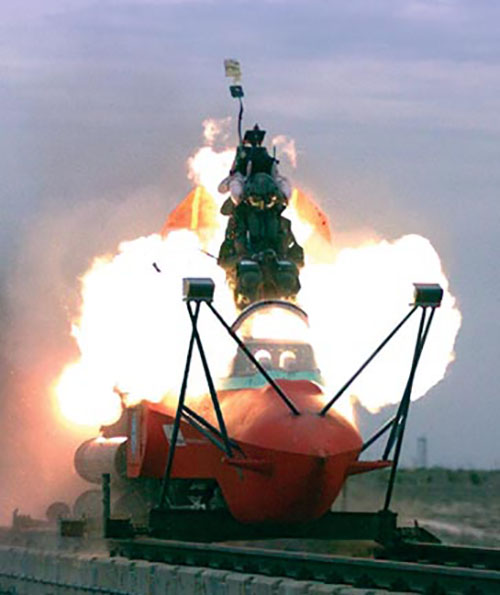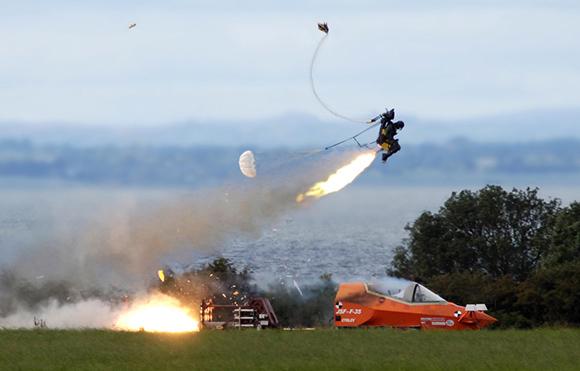The USAF is examining the possibility of replacing the Martin-Baker e-seat of the F-35 with the ACES 5 of the United Technologies. Such a move could have enormous repercussions on the F-35 international supply chain. The USAF confirms to DefenseNews not only the interest in the ACES 5 model, but also a note sent to the JPO (Joint Program Office) in order to evaluate the costs and the possible implications for the transition to the new seat.
The Department of Defense is working with Martin Baker and Lockheed Martin on three major corrections: design of a lighter helmet to reduce pressure on the pilot's neck, installation of a system that will delay the deployment of the main parachute and the assembly of a panel support for the head between the parachute risers.
In the seat built by the British company Martin-Baker, a "potentially fatal error for the life of the pilot" was found. This mistake already has a number of potential victims: a third of the pilots who will fly with the F-35. In the ejection phase, so we are in emergency conditions, the system would provoke such a violent whiplash due to a wrong position of the seat propelled outside the aircraft. The risk, recognized by the Department of Defense, is real for riders between 60 and 65 kilos.
Tests have shown that pilots, whose weight is close to little or too short at 135 / 140 pounds, have a probability of death equal to 98% during expulsions to 160 nodes. For those who did not know it is the average speed of a take-off or landing. American F-35-qualified pilots that fall into this weight category are steadily increasing. Their qualification has been suspended and will continue to fly only on the simulators. But the problem may have been underestimated because the percentage of risk remains high even for pilots with an average weight.

We must mitigate the risk - confirm from the Pentagon - we are evaluating the alternative represented by the ACES 5 model.
"We believe it is prudent to determine the cost, the impact on programming and on the timeline drawn up".
The note at the JPO was sent last Thursday. The Air Force states that "it was not required a different configuration of the aircraft, but only the costs of the possible transition".
The Pentagon hoped to solve the problem with a sort of "switch". The device, already tested, would be adjusted according to the rider's weight. When a lighter driver sits at the controls, the ejection device delays the release of the parachute by a fraction of a second, which is believed to reduce the impact on the rider's neck. A support device has also been added between the parachute risers to prevent the pilots' head from performing unnatural and potentially fatal movements. The two changes, according to the Pentagon, will be in production by the end of the 2016. Estimated, the latter, considered too optimistic by the Congress that provides at least a year of tests and optimizations before the production on a large scale. The problem with the helmet, on the other hand, will require even more time.
A rider who weighs 60 pounds, can not wear the current helmet from 400 thousand dollars. A pilot with a weight of 60 kilos (excess tolerance threshold and two kilograms), has a chance on 50 thousand to suffer a neck injury in case of expulsion. Riders who weigh between 63 and 74 kilos have less risk with a chance on 200 thousand to suffer a potentially fatal neck injury. Engineers are trying to reduce the weight of the helmet to prevent potentially lethal neck injuries for pilots being ejected from the aircraft. The helmet currently weighs 5,1 pounds. The minimum safety threshold to reduce potentially fatal risks is 4,6 / 4,8 pounds.
According to the report of the Department of Defense, the helmet weight corrections have a delay of at least nine months compared to the other two solutions identified. It would be correct to note that the restrictions will remain in effect until the three changes are in place. The implementations will require at least one year of testing. It was expected that the three corrections would be implemented by the summer of 2017. The Air Force, in an email from the last 8 January, acknowledged that the corrections will be implemented by December of the 2018.
The ACES 5 has a stabilization system that the company calls "STAPAC" and a headrest that pushes the pilots upside down during the expulsion. We need to understand why the Air Force is only now considering an option, eight months after having found the problems related to the safety of the pilots. Martin-Baker is part of the industrial participation strategy of the F-35 program. If the Air Force opts for the ACES 5 seat, the economic repercussions could be devastating both for the final cost of the aircraft and for mitigating lost revenues.
(photo: Martin Baker)












